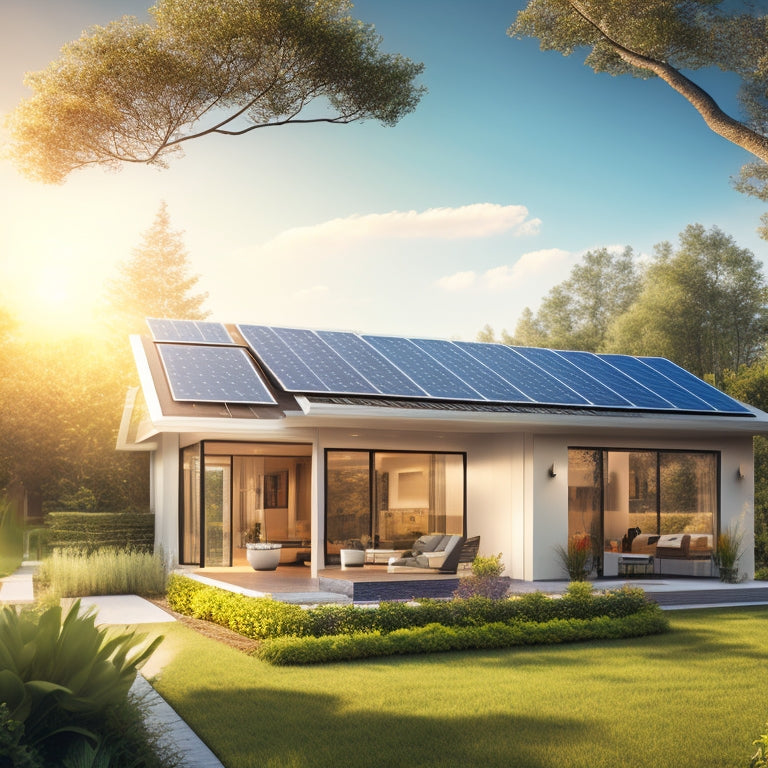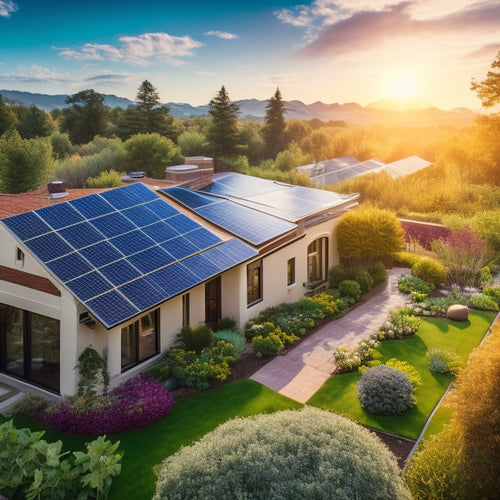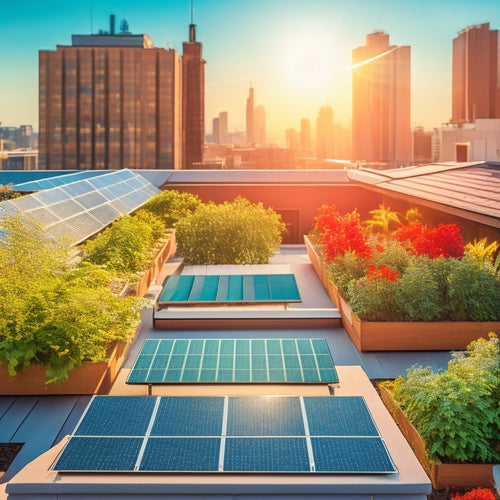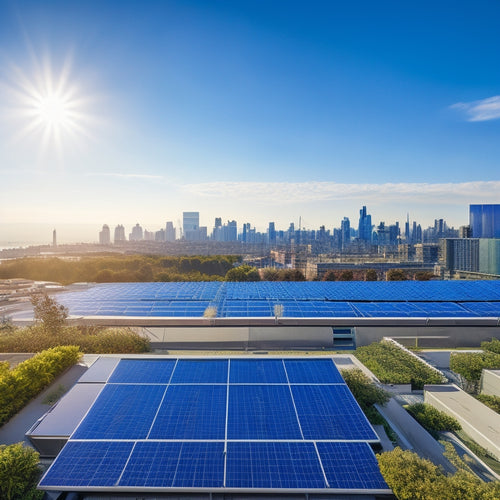
A Comprehensive Guide to Solar Energy for Homeowners
Share
As you investigate solar energy for your home, you'll reveal a cost-effective and environmentally friendly way to reduce your reliance on the grid and lower your carbon footprint. Contrary to common misconceptions, solar energy has become a viable option thanks to technological advancements. You'll benefit from energy independence, tax incentives, and increased home value. There are two primary types of solar panel systems: grid-tied and off-grid, each with its advantages. Understanding how solar energy works, from sunlight absorption to energy conversion, will help you make the most of your investment. Now, immerse yourself in the details to access the full potential of solar energy for your home.
Key Takeaways
- Solar energy is a cost-effective and environmentally friendly renewable energy source that reduces reliance on the grid and lowers carbon footprint.
- Grid-tied systems are the most common type, connecting to the grid and allowing excess energy sales, while off-grid systems offer complete grid independence.
- Solar panels convert sunlight into electricity through photovoltaic cells, with efficiency depending on quality and sunlight exposure, and can be optimized through technological advancements.
- The installation process involves assessing roof condition, evaluating energy needs, and managing permits, with financing options including loans, tax credits, and rebates.
- Solar energy can reduce electricity bills by $400 to $1,000 annually, with long-term savings contributing to a notable return on investment and enhanced property value.
Understanding Solar Energy Basics
As you consider utilizing solar energy for your home, it's vital to grasp the fundamental principles of this renewable energy source. One of the primary misconceptions is that solar energy is too expensive or inefficient.
However, these solar myths have been debunked by advancements in technology and economies of scale. In reality, solar energy has become a cost-effective and environmentally friendly alternative to traditional fossil fuels.
Solar energy utilizes the power of sunlight to generate electricity, reducing your reliance on the grid and lowering your carbon footprint. The environmental impact of solar energy is markedly lower compared to traditional energy sources, producing no emissions or pollution during operation.
Understanding how solar energy works is essential to making an informed decision about its implementation in your home. By dispelling common misconceptions and recognizing the benefits of solar energy, you can confidently consider it as a viable option for powering your home.
Benefits of Solar Energy Systems
Embracing solar energy systems can greatly change your home's energy environment. By utilizing the power of the sun, you'll reduce your reliance on fossil fuels, decreasing your carbon footprint and mitigating your environmental impact.
You'll also gain energy independence, shielding yourself from fluctuating electricity rates and price hikes.
In addition, you'll benefit from tax incentives, which can greatly offset the initial installation costs. Moreover, a solar energy system can increase your home value, making it more attractive to potential buyers if you decide to sell in the future.
Although installation challenges may arise, advancements in technology have made the process smoother and more efficient. Community solar programs are also becoming increasingly popular, allowing you to access the benefits of solar energy even if you can't install panels on your own property.
As the world shifts to a renewable future, investing in solar energy systems positions you at the forefront of this movement, enabling you to take control of your energy needs and contribute to a sustainable tomorrow.
Types of Solar Panel Systems
When you're considering solar energy for your home, you'll need to decide which type of solar panel system is right for you.
You have two main options: grid-tied systems, which connect to the grid and allow you to sell excess energy back to your utility company, and off-grid systems, which stand alone and provide independence from the grid.
Understanding the differences between these two systems will help you make an informed decision for your home's energy needs.
Grid-Tied Systems
You have two primary options for capturing solar energy at home: grid-tied systems and off-grid systems.
Grid-tied systems are the most common type, and they're ideal for homeowners who want to reduce their reliance on the grid without going completely off-grid. With a grid-tied system, your solar panels generate electricity and feed it into the grid through an inverter. When your system produces more energy than you're using, the excess is sold back to the utility company, and you receive a credit on your bill. This is possible due to a grid connection, which allows your system to synchronize with the grid's frequency and voltage.
A grid-tied system also comes with system monitoring capabilities, allowing you to track your energy production and consumption in real-time. This feature helps you identify areas for improvement and optimize your energy usage.
Since grid-tied systems don't require battery storage, they're generally more cost-effective than off-grid systems. Additionally, you'll still have access to the grid when the sun isn't shining, ensuring a steady supply of power.
Off-Grid Systems
Two out of every five homeowners who opt for solar energy choose off-grid systems, which allow them to disconnect from the grid entirely. This type of system is ideal for those who live in remote areas or want complete energy independence.
Off-grid systems require a larger upfront investment, but they provide the freedom to generate and store your own energy.
Here are the key components of an off-grid system:
- Solar panels: Convert sunlight into electrical energy.
- Solar battery storage: Store excess energy generated during the day for use at night or during power outages.
- Charge controller: Regulates the flow of energy from the solar panels to the batteries.
- Inverter/charger: Converts DC power from the batteries to AC power for your home and charges the batteries from the grid or generator when needed.
With an off-grid system, you'll also want to take into account remote monitoring, which allows you to track your energy production and consumption from anywhere.
This feature provides peace of mind, ensuring your system is running efficiently and effectively, even when you're not at home.
How Solar Energy Works
You're likely wondering how solar energy works, and it all starts with your solar panels.
These panels are composed of photovoltaic (PV) cells that convert sunlight into electrical energy through a process known as photovoltaics.
As you'll soon learn, this energy conversion process relies on a precise mechanism that absorbs sunlight and generates a usable current.
Solar Panel Functionality
As sunlight hits a solar panel, it excites the electrons in the photovoltaic (PV) cells, triggering an electrical current. This process relies on the principles of photovoltaics, where light energy is converted into electrical energy. The efficiency of this process depends on various factors, including the type and quality of the solar panel, as well as the amount of sunlight it receives.
To maximize solar panel efficiency, manufacturers have made significant advancements in solar technology.
Some of the key developments include:
-
Thinner silicon wafers: Reducing the thickness of silicon wafers increases energy conversion rates while decreasing production costs.
-
Anti-reflective coatings: These coatings minimize energy loss by reducing reflection and increasing absorption of sunlight.
-
Bifacial panels: These panels can absorb light from both the front and back sides, increasing energy output by up to 25%.
- Perovskite cells: These cells have shown higher power conversion efficiency rates than traditional silicon-based cells.
Energy Conversion Process
Efficiency unfolds when sunlight meets photovoltaic cells, sparking an intricate dance of energy conversion. As a homeowner, understanding how solar energy works is essential to utilizing its power. The process begins with photovoltaic technology, which converts sunlight into electrical energy.
| Step | Description |
|---|---|
| 1. Excitation | Photons from sunlight excite electrons in the photovoltaic cells, allowing them to flow freely. |
| 2. Flow | The energized electrons flow through the material, creating an electrical current. |
| 3. Collection | The current is collected and directed through an inverter, converting DC power to AC power usable in your home. |
This intricate process enables solar energy efficiency, allowing you to tap into a clean, renewable source of power. By understanding the energy conversion process, you can optimize your solar panel system to maximize energy production and reduce your reliance on the grid. With photovoltaic technology, you're one step closer to utilizing the power of the sun and taking control of your energy needs.
Sunlight Absorption Mechanism
The sunlight absorption mechanism is the initial stage of the solar energy conversion process, where photons from sunlight interact with the semiconductor material in photovoltaic cells. As you consider utilizing solar energy for your home, it's crucial to understand how this mechanism works.
When sunlight hits a photovoltaic cell, it excites the electrons in the semiconductor material, allowing them to flow freely. The intensity of the sunlight, measured as solar irradiance, directly affects the amount of energy generated. The more intense the sunlight, the greater the energy output.
Here are the key factors that influence the sunlight absorption mechanism:
-
Sunlight intensity: The amount of energy received per unit area, measured in watts per square meter (W/m²).
-
Solar irradiance: The total amount of sunlight energy received over a given period, measured in kilowatt-hours per square meter (kWh/m²).
-
Cell temperature: Higher temperatures can reduce the efficiency of the photovoltaic cells.
- Cell material quality: The type and quality of the semiconductor material used in the photovoltaic cells affect their ability to absorb sunlight efficiently.
Solar Panel Installation Process
You're about to take the first step towards utilizing renewable energy: installing solar panels on your rooftop. Before the installation process begins, your solar panel provider will assess your roof's condition, ensuring it's structurally sound and suitable for the chosen solar panel type.
They'll also evaluate your energy needs, determining the ideal system size and configuration.
The installation timeline typically spans several weeks to a few months, depending on the complexity of the project and local permits. The process involves several stages: site preparation, racking and mounting, panel installation, wiring and electrical connections, and final inspections.
Your provider will handle all necessary permits and inspections, ensuring compliance with local building codes and regulations.
When it comes to solar panel types, you'll typically choose between monocrystalline, polycrystalline, or thin-film panels. Each has its advantages, such as efficiency, cost, and aesthetic appeal.
Your provider will help you select the best option for your energy needs and budget. With a well-planned installation process, you'll be utilizing the power of the sun in no time.
Cost and Financing Options
As you move forward with your solar panel installation, understanding the cost and financing options becomes a crucial aspect of the process. The overall cost of solar panels can vary depending on factors such as the system size, equipment quality, and installation company.
However, there are various financing options available to make solar energy more accessible.
To help you steer through the financing process, consider the following:
-
Incentive programs: Federal and state governments offer tax credits and rebates to encourage homeowners to adopt solar energy. Research the programs available in your area to maximize your savings.
-
Financing calculators: Online tools can help you estimate the cost of solar panels and calculate your potential savings. These calculators can also provide information into the payback period of your investment.
-
Loans and financing plans: Many solar installation companies offer financing options, such as loans or power purchase agreements, to help you spread the cost over time.
- Property assessed clean energy (PACE) financing: This program allows you to finance your solar panel installation through a property tax assessment, which can be repaid over several years.
Energy Savings and ROI
Beyond the environmental benefits, one of the most notable advantages of solar energy is its potential to save you money on your electricity bills. By utilizing the power of the sun, you can greatly reduce your reliance on the grid and lower your energy expenses.
The amount you save will depend on several factors, including the size of your solar panel system, your energy usage, and the local electricity rates.
On average, homeowners who invest in solar energy can save between $400 and $1,000 per year on their electricity bills. Over time, these savings can add up, providing a notable return on investment (ROI).
Additionally, many incentive programs are available to help offset the upfront cost of solar energy systems, making it more accessible and affordable for homeowners.
With long-term savings and potential increases in your property value, investing in solar energy can be a smart financial decision for you. By going solar, you can enjoy both environmental benefits and financial gains, making it a win-win situation.
Maintenance and Repair Tips
With your solar panel system up and running, it's time to focus on guaranteeing it continues to operate at peak performance. To achieve this, you'll need to perform regular preventive maintenance, troubleshoot any issues that arise, and optimize system performance.
Here are some essential maintenance and repair tips to keep in mind:
-
Regular cleaning: Clean your solar panels regularly to guarantee maximum energy production. Use gentle cleaning methods to avoid damaging the panels.
-
System monitoring: Keep an eye on your system's performance using monitoring software or apps. This will help you identify any issues promptly.
-
Professional inspections: Schedule annual or bi-annual professional inspections to identify potential problems and guarantee your system is running efficiently.
- Warranty considerations: Understand your warranty terms and conditions to guarantee you're covered in case of equipment failure or malfunction.
Frequently Asked Questions
Can I Install Solar Panels on a Rented Property?
Before installing solar panels on a rented property, you'll need to get your landlord's permission, which may involve reviewing and revising your lease agreements to guarantee you're both on the same page.
Do Solar Panels Work During Power Outages?
You'll stay powered during outages with a solar battery, achieving grid independence and emergency power; however, consider the added installation costs and maintenance requirements, assessing them against the benefits of energy savings and increased system efficiency.
Can I Use Solar Energy to Charge My Electric Vehicle?
As you drive your electric vehicle, imagine utilizing the sun's energy to fuel your trip; with solar charging, you'll access EV benefits like reduced emissions and lower operating costs, ensuring a smooth ride towards a sustainable future.
Are Solar Panels Affected by Weather Conditions Like Hail?
You'll be relieved to know that most solar panels are designed with hail resistance in mind, but you should still consider the weather impact, as extreme conditions can affect their performance and longevity.
Can I Sell Excess Energy Back to the Grid?
You can sell excess energy back to the grid through net metering benefits, which allow you to offset your consumption and receive credits, or participate in energy buyback programs, where utilities purchase your surplus energy at a predetermined rate.
Conclusion
You've taken the first step towards utilizing the power of the sun, and now you're ready to shine. With a solid grasp of solar energy basics, benefits, and types of systems, you're equipped to make an informed decision. You know how solar energy works, the installation process, and the costs involved. You're aware of the energy savings and ROI, as well as maintenance and repair tips. Welcome the switch to solar, and get ready to reduce your carbon footprint, lower your energy bills, and increase your property's value.
Related Posts
-

Sustainable Solar Energy for Cost-Effective Living
Adopting sustainable solar energy isn't just eco-friendly; it's a smart financial strategy. You'll slash your monthly...
-

Solar System Installation Rebates and Tax Credits
Solar system installations offer beneficial rebates and tax credits that greatly cut your initial costs. You can bene...
-

Business Solar Investments for Cost-Effective Sustainability
Investing in solar energy is a smart move for your business, providing a solid foundation for cost-effective sustaina...


